
Vintage Pistols Home >> Range Reports >> Glock 17 Range Report
Glock 17 - 9mm (9x19)
I hated Glocks for years. I didn't like the way they looked, I didn't like the way Glock enthusiasts raved about them like a bunch of brainwashed moonies, I hated the way idiots would tell me they were ceramic, and I didn't want to own one. Ever. I considered myself a "purist". I liked 1911's and blued S&W revolvers, and would tell you at length why they were better than the latest tactical Tupperware™. In short, I was an ass. I got better though, and I have my brother to thank for it.
He has a Glock 17, and after bugging me for months convinced me to take it home and try it out. The way a gun feels in your hand is a personal thing, and I'm pickier than most. I have big thick hands. I shoot lefty; not by choice, but because I accidentally amputated the ends the index and middle fingers of my right hand. Until the accident, I don't think I'd ever even picked up a handgun with my left hand. Anyway, I took the Glock, loaded up a mag, stuck it in the pistol, racked the slide, pointed it at the target, and... it felt like part of my hand. I don't know what it is - some combination of grip angle, width, and thickness - but some guns (to me) just feel natural. The 1911 is that way, the Luger is that way, and the Glock is that way. It's no coincidence that these are, arguably, three of the five "classic handguns of all time" (along with the Colt SAA and S&W M&P/Model 10 revolver). When I grabbed the Glock and held it in front of me, the front site was on target and in the middle of the rear site. Within a week of trying out my brother's, I bought one for myself. I owned a Glock:
|
Click on a picture for a larger image |
||
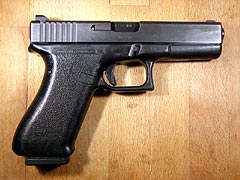 |
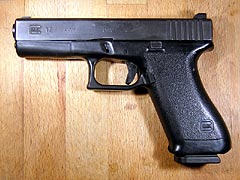 |
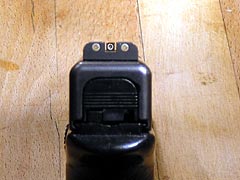 |
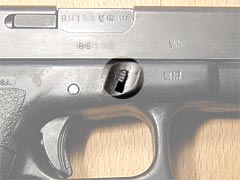 |
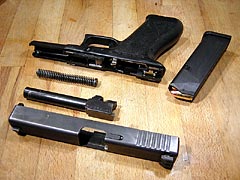 |
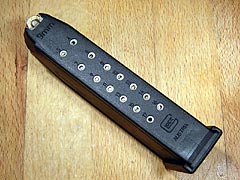 |
The Glock 17 is a recoil operated, locked breech pistol. It features a Browning-type linkless locking system, with the barrel interlocking to the slide via the ejection port. It features Glock's patented "Safe action" striker-fired trigger mechanism: After the each cycle of the slide, the striker is set to the "half-cock" position and is safely blocked by the internal safety. When you pull the trigger, the trigger safety disengages, the striker cocks to the "full-cock" position, and then the gun fires. This results in a constant-force trigger pull and, unlike the traditional DAO pistols, the inability to strike the round a second time in the case of the misfire. There are no external controls except the trigger, slide release, and takedown lever (if you want to call that a control).
Mine is a full-size, old-school, original, "1st generation" Glock 17. This was the one that started it all - Glock went from making shovels, to making these. It features a polymer frame and cast steel "Tenifer" treated slide. It has the plain stippled grips and no accessory rail. It has fixed luminous (Trijicon?) sights that have become dim with age. I bought this pistol used from a guy that bought it used. I have no idea how many rounds have been put through this pistol, but there are shiny worn spots on the frame like I've never seen on any another Glock. This pistol has character.
Here are the specs, straight from the Glock site:
| CALIBER 9x19 SYSTEM Safe Action |
 |
WEIGHT 625 g / 22.04 oz. LOADED (~) 905 g / 31.91 oz. |
|
 |
LENGTH 186 mm / 7.32 in. HEIGHT 138 mm / 5.43 in. |
 |
MAG. CAPACITY Standard: 17 OPTIONAL 19 / 33 |
 |
WIDTH 30 mm / 1.18 in. BARREL HEIGHT 32 mm / 1.26 in. |
 |
TRIGGER PULL 2.5 kg / 5.5 lbs. TRIGGER TRAVEL 12.5 mm / 0.5 in. |
 |
LINE OF SIGHT 165 mm / 6.49 in. BARREL LENGTH 114 mm / 4.49 in. |
 |
BARREL RIFLING right hand, hexagonal LENGTH OF TWIST 250 mm / 9.84 in. |
The Trigger
There's no manually operated safety on the Glock. Instead, there's a little lever smack-dab in the middle of the trigger called the "trigger safety".
The trigger won't move unless this lever is depressed; it keeps the pistol from firing if something catches on the side of the trigger.
The act of pulling the trigger also disengages a firing pin safety and something Glock calls the "drop safety". Together, these make up Glock's "Safe Action".
Safe or not, some people never get used to the little lever in the middle of the trigger. The first time I fired a Glock I thought,
"Hey, there's a little lever in the trigger", and then forgot about it. This is one of those pistols you'll definitely want to try before buying - just
to make sure that you don't hate the trigger.
The trigger pull itself is short for a DA trigger (because the hammer is already half-cocked) and much lighter than I expected. The pull is in the neighborhood of 5 pounds; I guess I was expecting a 10+ pound revolver-type pull. The break is quite mushy - this ain't a bullseye pistol - but the trigger reset is quick.
Shooting it
Before taking my brother's G17 to the range, I asked him what kind of ammo it liked and he said, "Anything nine. Just take it out and shoot it like you stole it.
If you can fit in the mag, it will shoot it." So to prove him wrong, I collected every disparate type of 9x19 ammo I could put my hands on - cheap stuff, expensive
stuff, normal-looking hollowpoints, funny-looking hollowpoints, and last but not least, some troublesome handloads that I made while I was learning to handload (back when
I thought that C.O.A.L. was something you got in your stocking when you were B.A.D.).
That day at the range, the damn thing ate everything. My neighbor and I put 300 rounds through it and had zero failures-to-do-anything-but-go-BANG. Being the good guy that I am, I cleaned it, put it back in its stupid Tupperware box, brought it back to my brother, and went looking for my own. I bought the well-worn example in the pictures above for the princely sum of $275, and it shoots the same way as the one I borrowed from my brother.
I don't reload 9mm (it's still inexpensive enough) and I shoot lots of cheap factory ammo for practice. From Winchester White Box, to cheap Remington UMC, S&B, and gun show reloads, if there's some cheap 9mm that my G17 won't feed, then I haven't found it.
You're not supposed to shoot lead bullets or reloads in a Glock. I occasionally do both. One thing I won't do is to shoot jacketed ammo after shooting lead. The Glock barrels will lead up. Shooting jacketed bullets out of a heavily leaded barrel can produce dangerously high pressures which can result in the dreaded "kaBoom!" or kB! for short. After shooting lead bullets, I thoroughly clean and de-lead the barrel (if needed) before shooting jacketed bullets. For carry ammo, I use Gold Dot hollowpoints.
The G17 that I bought came with two 17-round and two 10-round magazines. The ten-rounders load up OK, but you'll wear out your thumb trying to get the last round into a 17-round magazine. I don't have a magazine loader, so I usually only load 16 rounds. Even when I do manage to jam the last round in, the feed lips on the magazine visibly spread out. Since the high-cap mags are hard to come by here in Massachusetts, rather than stress them, I load one less round.
I find the Glock to be an accurate and quick-shooting pistol. Like I indicated earlier, this is by no means a bullseye pistol. But once you get used to the trigger, you can get some decent groups. Shooting quickly from 7 yards, I can group 17 shots into under 3" all day long. Shooting slowly and deliberately from an improvised rest, I can shoot similar groups at more than twice that distance. The accuracy is good enough for a defense/combat pistol.
Field Stripping
The Glocks (the G17 included) are among the easiest pistols to field strip. Here are the steps:
- Remove the magazine and make sure the pistol is unloaded.
- Pull the trigger to drop the hammer.
- Retract the slide about 1/8".
- Pull down (toward the trigger) both sides of the takedown lever (photo 4 above).
- Pull the slide forward off the frame.
- Pull out the recoil spring/guide rod assembly.
- Lift and remove the barrel. The pistol is now field stripped.
When reassembling the pistol, ensure that the guide rod/captive recoil spring assembly is properly oriented. If you put it in backwards, you won't be able to rack the slide. There are plenty of aftermarket "upgrades" you can get for the G17, but one that I strongly recommend is an extended takedown lever. The extended lever is slightly longer (meaning that the ends protrude out of the frame about 1/32" more) than the standard takedown lever. It might not seem like much, but the extended lever makes the pistol much easier to take down without making it harder to carry, conceal, or draw. It's a cheap part (less than $10), and can be installed in seconds.
Conclusion
I still don't like the way it looks. I still hate having to explain to people that it
will set off a metal detector, it's not made out of ceramic, and just because Bruce
Willis said it in Die Hard, doesn't mean it's true. However, I'm still glad
I bought this pistol. I hate to use the word "beater", but there's something to be said for
having a reliable pistol that you can let get muddy, sandy, or wet and not feel like you're
wrecking it.
Report by EddieCoyle - 2/17/2007